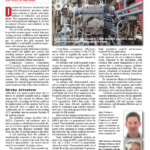

- Industries
- Solutions
- Services
- About CCC
- Media Center
- Contact
Enhance your turbomachinery performance and reliability by leveraging the power of digital and embedded expertise.
WATCH NOWAvoiding Speed Instability in Steam Turbines
Steam turbine governor retrofit using electro-hydraulic actuator improves reliability and performance

Fill out the form to download the FREE white paper “Avoiding Speed Instability in Steam Turbines”.
Download your FREE copy today!
Contents Preview
Decades-old low-tech mechanical and hydro-mechanical governor equipment continues to operate with many turbines in refineries and process plants. This equipment can present maintenance and operational challenges. It can lead to reduced efficiency and reliability in the production process.
The job of the turbine speed governor is to provide accurate speed control, thus preventing process oscillations and unplanned shutdowns, and improving process throughput. To achieve this goal precisely and dependably, it is advisable to perform a governor valve actuation retrofit.
Advantages include stabilization of equipment speed with tighter rpm control, and avoiding nuisance process and equipment trips. This enables the turbine to operate at its maximum potential without interruption.
Compressor Controls Corporation (CCC) recently implemented a mechanical retrofit for a U.S. refinery experiencing large swings (100-200 rpm) in the speed control of a steam turbine (ST). Speed instability was caused by a subpar governor valve actuation system. The sticking actuator could not maintain the setpoint target and had recently caused a process trip of the main air blower.
Sticky actuators
Difficulties with speed control meant the ST had to be operated manually and at a higher target speed than desired. In addition, load sharing with a secondary air blower could not be implemented, and the operator had to use the blow-off valve to adjust the air flow. Additionally, the ST could not use the existing CCC automatic start-up sequence because of the sticking actuator.
The actuation system specified was a REXA Electraulic self-contained unit. It uses a position-controlled power module driven by a 4-20 ma signal to turn an internal oil gear pump that displaces hydraulic fluid from one side of cylinder piston to the other.